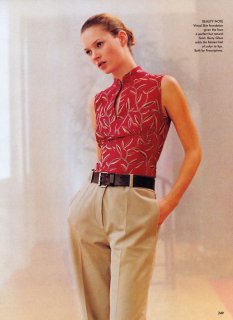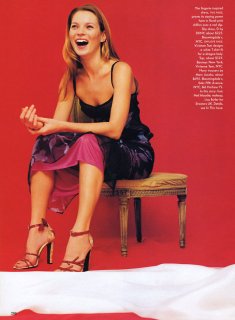hellimaria
Member
- Joined
- May 20, 2005
- Messages
- 100
- Reaction score
- 5
Comment & Watch Live... The 2025 Victoria's Secret Fashion Show

The Smithsonian’s Hirshhorn Museum and Sculpture Garden presents the East Coast debut of a major U.S. survey of the work of German artist Wolfgang Tillmans from May 10 through Aug. 12. Tillmans is acclaimed as a chronicler of his generation and has garnered international recognition as one of the most significant artists to emerge in the 1990s. Working in photographic genres such as documentary, portraiture, landscape and still life, he creates evocative images that reflect on often overlooked moments and occurrences in everyday life. The survey features approximately 300 photographs, a video and installations of works that span the artist’s career.
"Wolfgang Tillmans" is co-organized by the Hammer Museum, Los Angeles, and the Museum of Contemporary Art, Chicago. The exhibition is curated by Russell Ferguson, adjunct curator at the Hammer Museum and chair of the department of art at the University of California in Los Angeles, and Dominic Molon, Pamela Alper associate curator at the Museum of Contemporary Art in Chicago.
“Wolfgang Tillmans is widely recognized for having reshaped the practice and display of photography," said Hirshhorn Deputy Director and Chief Curator Kerry Brougher. "He is concerned about opening up new possibilities for photography, continuing in a direction that was first explored in the early 1960s, when artists such as Andy Warhol, Gerhard Richter and Sigmar Polke blurred the line between photography and painting, while others like John Baldessari, Ed Ruscha, Dan Graham and Richard Prince used snapshots or appropriated existing photographs to create conceptual art pieces. Cindy Sherman and Jeff Wall continued in that mode by confusing the boundaries between photography and cinema."
Tillmans' work challenges established photographic conventions by combining a sense of immediacy with carefully considered compositions to produce intimate and visually dynamic reflections of contemporary life. He rejects traditional hierarchy in subject matter with distinctive installations created specifically for each presentation. These non-traditional arrangements span entire walls and galleries, incorporating clusters of ink-jet prints and C-print photographs that vary in size. Mixing framed and unframed photographs in the installation, the artist draws out relationships within the body of images as well as associations suggested by the individual pictures.
“Although many of Tillmans’ photographs are highly memorable, even iconic, they remain fundamentally untheatrical and rooted in a social context,” said Ferguson. “It is even possible to see all of his photographs as an ongoing, extended self-portrait, a record of his passage through the world.”
While certain works are notably singular and iconic, his use of a shifting scale for his prints and an ever-changing rotation of images with each successive installation demonstrates his desire to see all of his pictures as universally significant. The vast range of his images becomes an ongoing “palette,” which he uses repeatedly as a way to continually reinterpret his photographic vision. In doing so, Tillmans suggests that an unassuming image of jars of jam on a countertop is just as significant as an image of a bolt of lightning or a political rally. By applying the same clarity of vision and intensity of purpose to every picture, Tillmans offers a visually unified perspective on the diverse phenomena that comprise the broad spectrum of lived experience.
Born in Remscheid, Germany, in 1968, Tillmans studied at the Bournemouth & Poole College of Art in Dorset before moving to London, where he lives and has worked since 1995. Early in his career, Tillmans documented the European club scene in a manner that captured its dynamic style with an affecting sincerity, and he presented this work in carefully crafted spreads for British fashion and lifestyle magazines. He increasingly developed a signature style, intimately presenting subjects ranging from still lifes to portraits of friends and celebrities, subtly alluding to his interest in issues such as homelessness, racism and gay rights. Despite his use of magazine layouts as an early vehicle for his work, his provocative images always challenged the superficial gloss of the fashion industry and subverted notions of beauty and sexuality.
Since the 1990s, Tillmans' work has turned increasingly toward abstraction. The exhibition at the Hirshhorn includes his new, purely abstract works, which are created through the direct manipulation of light on paper rather than the use of a camera. Among the series he has produced in this manner are "Blushes," "Mental Pictures" and "Freischwimmer." Despite their nonrepresentational status, these images—particularly the lush "Freischwimmer" pictures with their sinewy or hair-like lines—still possess a tactility and physicality that gives them an almost bodily feel.
Tillmans was awarded the prestigious Turner Prize in 2000 by the Tate Modern in London, which recognizes the works of artists younger than 50 who have distinguished themselves nationally in Great Britain. His work has been presented in solo exhibitions at numerous international museums, most recently at P.S. 1 Contemporary Art Center in new York (2006); the Tokyo Opera City Art Gallery (2004); the Tate Modern in London (2003); the Louisiana Museum of Modern Art in Denmark (2003); the Palais de Tokyo in Paris (2002); and the Diechtorhallen in Hamburg, Germany (2001). Tillmans's work also has been included in major group exhibitions such as "Covering the Real: Art and the Press Picture from Warhol to Tillmans" at the Kunstmuseum Basel in Germany (2005); "Open City: Street Photographs since 1950" at the Hirshhorn Museum (2002) "Moving Pictures" at the Guggenheim Museum in New York (2002); "Uniform" at the Stazione Leopolda in Florence, Italy (2001); and "The British Art Show 5" at the Hayward Gallery in London (2000).
Works by Tillmans have been acquired by the Hirshhorn Museum and Sculpture Garden; The Art Institute of Chicago; The Metropolitan Museum of Art in New York; MIT List Visual Arts Center in Cambridge, Massachusetts; Modern Art Museum of Fort Worth, Texas; Museum of Contemporary Art in Chicago; and the Walker Art Center in Minneapolis.



[FONT=verdana,helvetica,arial,sans-serif][SIZE=-2] Wolfgang Tillmans's photographs of friends, dance raves, clubs, and night life have appeared regularly in London's i-D magazine and other publications since 1989. Though his work has had a tremendous impact on the studied casualness of much recent fashion photography, Tillmans is not a "fashion photographer." If anything he is a portraitist who often photographs his friends—who appear alternately tough, vulnerable, loving, ferocious, gay, and straight—in intimate situations. Though these probing images reflect his own subjective experiences, they also operate on a more general level, recording a specific dimension of our contemporary culture. Tillmans establishes a collaborative process with his models, whom he calls "accomplices." Thus the informal look of the works belies their choreographed construction. Landscape and still-life images also play a crucial role in his oeuvre, in which half-eaten fruit, sewer rats, crumpled clothing, or urban skylines are photographed with the same dignity and attention to beauty as his human subjects. Traditional subject genres are questioned; crumpled clothing might suggest a figure or landscape, while city scenes seen from the air resemble a still life of objects.
For Tillmans, the images are only half the work; the installation or layout constitutes its completion. He affixes his prints directly to the wall with pins or tape, juxtaposing old and new images of varying sizes and mediums. He eschews standard darkroom procedures, blurring the lines between color and black and white (printing black-and-white images on color paper, for instance). Color photographs are placed next to inkjet prints and next to postcards and magazine clippings of his own images, contesting conventional hierarchies of scale and subject matter while drawing focus to the materiality of the photographic medium—all within a carefully composed environment that seems to disdain permanency.[/SIZE][/FONT]

















